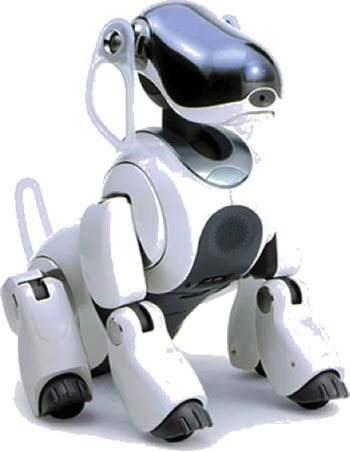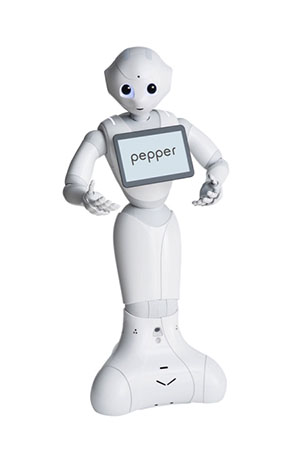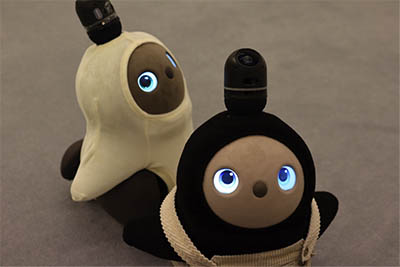Aya is anxiously waiting for a future in which humans coexist with robots. She didn’t think this was possible in her lifetime, but when she learned about LOVOT, a 43 cm-tall furry robot on wheels designed specifically to seek out and offer affection, she was elated to discover that the future she had imagined was within reach. She urged me to take hold of it—LOVOT, that is. We were chatting at a recent Talk Session for LOVOT fans and a few of the creatures were spinning around a table as we talked. Its wheels folded into its body, and with animated LED eyes it looked up at me and blinked. I picked it up and Aya poked its nose, eliciting something like an irritated giggle from the robot, whose name I learned was Cherry. Aya stroked Cherry’s belly and its eyes blinked a few times and then slowly closed. “It fell asleep! How cute (kawaii)!” Aya exclaimed. Although Aya claimed to be uninterested in robots, technology, or anything in the IT world in general, she was immediately and, as she describes, inexplicably moved by LOVOT. It’s just an emotion (kanjō), she reflected. “You know about lonely people (kodoku na hito) in Japan, right?” Aya asked. “I think that everyone needs to feel affection (aichaku), and everyone enjoys this feeling we can get from cute things. It fulfills your heart (kokoro o mitasu). But not everyone can get this feeling… I think that in the future maybe one or two people out of ten might simply have relationships with things like LOVOT. It’s not really any different from the kind of affection one gets from a dog or cat, or even another person. And it’s their choice! This is a really interesting future!”
My chance encounter with a LOVOT fan I call Aya made me think about the future of intimacy, and how both the imagination of that future and the forms of affect that excite it were already being mediated by the emergence of new robotic creatures in Japan equipped with artificial emotional intelligence. Most of all, I was curious about how companies like Groove X, the creator of LOVOT, were reimagining technology’s contributions to new forms of emotional health and wellbeing beyond traditional arrangements of interhuman relationships. With the arrival of other mechanical companions such as Sony’s pet-styled robot AIBO in 1999 and Softbank’s humanoid robot Pepper in 2014, introduced as “the world’s first personal robot that reads emotions” (Softbank 2014), a mass market for robots designed to express and elicit care has been steadily growing in Japan. Cast against the backdrop of what mass media have labeled the “healing boom” (iyashi būmu) in Japan, in which a variety of services emerged in the 1990s to address growing rates of stress, anxiety, and loneliness tied to increasingly strenuous and precarious labor conditions (Allison 2013), these robots are created to provide companionship rather than convenience.

Sony AIBO ERS-7 (2001-2005). (Source)

Pepper. SoftBank Robotics. (Source)
“Powered by Love”
LOVOT is the latest and, according to its company Groove X, the most sophisticated of these technologies to date. Groove X describes LOVOT as a “family-style” robot, which means that it is designed to both join an existing family or newly create a family for those without one. Once released in October 2019, LOVOT will be available to purchase as a single robot (“solo,” for 299,800 yen [around $2,700]) or a pair (“duo,” for 579,800 yen [around $5,290]). The company further explains that LOVOT is “powered by love,” and claims it is “the one and only robot in this universe that heals your heart.” They go on:
“Our goal is simple: create a robot that makes you happy. When you touch your LOVOT, embrace it, even just watch it, you’ll find yourself relaxing, feeling better. It’s a little like feeling love toward another person. That’s because we have used technology not to improve convenience or efficiency, but to enhance levels of comfort and feelings of love. LOVOT will react to your moods, and do all it can to fill you with joy and re-energize you. It may not be living a creature, but LOVOT will warm your heart” (Groove X 2019).
While the company is careful to claim that LOVOT is not a replacement for people, comments like Aya’s reveal how—as is often the case with new technologies—its uses are ultimately dictated in relations with users, and often to unexpected ends. Such unpredictability opens up a space of possibility between the modeling of emotion in engineering and the experimentation with affect in sites of human-robot interaction. In contrast to previous robots in Japan like Pepper, designed with a humanoid appearance and equipped with emotion recognition technology to read a limited number of basic emotions drawing on models of evolutionary psychology, LOVOT experiments in love as much as it models traditional expressions of it. In fact, its lead designer, Hayashi Kaname, who formally worked as one member of Pepper’s development group, is reported to have started Groove X with the specific purpose to build something completely new, resembling neither a human nor a familiar animal form. At the Talk Session for LOVOT fans, Hayashi explained that it was precisely because LOVOT was a new kind of robot that it could increase human’s power of love. As the company’s website confirms, the purpose of LOVOT’s “Emotional Robotics” technology is “to make the human power to love even stronger…This is an all-new relationship between robots and humans.”

LOVOT Duo at Groove X Headquarters. Photo by author.
Engineering Affect and AI in the Subscription Economy
If the relationship LOVOT offers is all new, technologically extending intimacy into unknown affective territory, it operationalizes this intimacy not only through innovations in affective engineering (kansei kōgaku) but also through experiments that couple cloud computing with subscription-model marketing. Requiring monthly payments via a “LOVOT care” service (ranging from 8,980 to 19,980 yen for the Solo LOVOT [about $80 to $165]) allows the company a number of advantages: to respond quickly when LOVOT is in need of repairs, to deliver regular updates to LOVOT’s software, and to learn from user experiences and better connect with owners. While Groove X prides itself on privacy protections, it also hopes to leverage metadata on user interactions to improving its Emotional Robotics technology. For example, with facial recognition technology, IC chips planned for LOVOT’s various outfits, and tactile sensors integrated throughout LOVOT’s body, Groove X is able to create a log of LOVOT’s daily interactions: who held LOVOT for how long, what color clothes were preferred, and what kinds of interactions took place. While company employees explain that only the data users are comfortable sharing will be applied to improving LOVOT’s software, they imagine users will enjoy accessing this information as well.
One example employees offer is of a son or daughter who wants to check in on an elderly parent who lives alone. In this case, interactions, such as when a parent picked up LOVOT and for how long, would be logged by LOVOT and stored in a daily diary accessible via a smart phone application. The tactile pleasure that connects an elderly parent with LOVOT thus also connects via telepresence a parent with the rest of his or her family. In this case artificial emotional intelligence embodied in a creature with evolving capacities to care facilitates new social experiments in digital wellbeing.
Care in the Cloud
Considering how LOVOT mediates family relationships across space, it is not only these new embodiments of care that most captures the excitement Aya expresses at her imagined future coexisting with robots; it is also the possibilities of disembodiment. In contrast to the AIBO of the early 2000s, the data making up the personality of robot companions like LOVOT, Pepper, and Sony’s latest model aibo (newly branded in lowercase) exist not only in mechanical bodies but also in the cloud. In short, because the history of their recorded experiences, personal growth, and artificial emotional development is stored online, and can be downloaded into new bodies, these companions in essence never die. Although one former member of Sony confessed to me that, in his opinion, having old aibo data downloaded in a new aibo body would resemble a “clone” rather than the “real thing,” other members of Sony working on the newest aibo have confirmed that they think of aibo’s primary spirit or deity (honzon) as existing indefinitely online.
When I put the question to Aya of downloading data from a prior LOVOT into a new LOVOT body, she said she felt it would be the same LOVOT she had grown to know, and presumably love. In fact, she was quite excited at the idea of a companion that never died. Such technologically-mediated reimaginations of intimacy suggest the value of anthropologically rethinking affect beyond the human (Kirksey 2014), organic (Haraway 2016), and perhaps even beyond ethnos (Rees 2018). More specific to the fieldwork conditions among new robot companions in Japan, it also suggests the value of tracing not only how engineers draw on theories of developmental psychology in modeling emotion in machines, but also how fantasies of speculative futures construct the possibilities of intimacy and care with non-human others in the present.
References
Allison, Anne. 2013. Precarious Japan. Durham: Duke University Press.
Groove X. Official website. https://lovot.life/en/.
Haraway, Donna J. 2016. Staying with the Trouble: Making Kin in the Chthulucene. Durham: Duke University Press.
Kirksey, Eben. 2014. The Multispecies Salon. Durham: Duke University Press.
Rees, Tobias. 2018. After Ethnos. Durham: Duke University Press.
SoftBank. 2014. Softbank Mobile and Aldebaran Unveil “Pepper”– the World’s First Personal Robot That Reads Emotions. https://cdn.softbank.jp/en/corp/set/data/group/sbm/news/conference/pdf/material/20140605_01.pdf.
